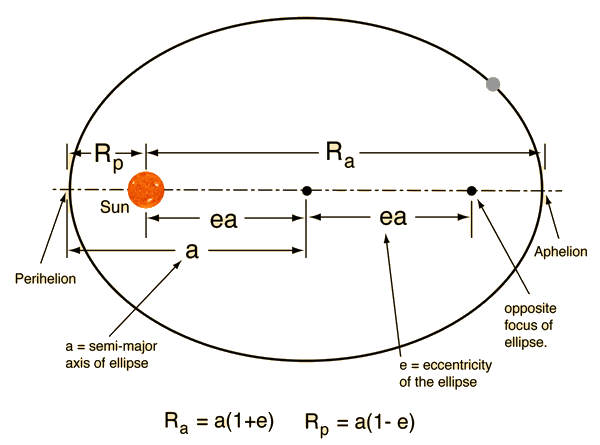Kepler's First Law

The orbit of every planet is an ellipse with the Sun at a focus
Before Kepler, it was thought that planets traveled around the Sun in a perfect circle. Instead, the Sun resides at one of two foci. The discovery of elliptical orbits helped to explain the motion of and interaction between planets as well as comets and asteroids.
Kepler's Second Law

The line joining a planet and the Sun sweeps out equal areas during equal intervals of time
This law is a little more difficult to understand at first glance. It is generally believed that the Earth travels at the same speed all the time, but this is a misconception. Because the planet orbits the Sun in the shape of an ellipse it is not always the same distance from the Sun. And the closer it is to the Sun, the faster it goes. The picture above depicts two different periods of equal time in the path of a planet. Though the Earth moves farther in a given time when closer to the Sun, the area it sweeps out when a line is drawn between it and the Sun remains constant for that given time. In other words, the two shaded areas are exactly equal. This may seem like a small thing, but it helps us to understand the variable motion of the planet which aids us in calculating what the real time is (which allows us to calculate leap days, leap minutes, leap seconds, etc. which keep Spring on the 21st day of March).
Kepler's Third Law
The square of the orbital period of a planet is directly proportional to the cube of the semi-major axis of its orbit
In simpler terms, the only thing that determines the length of a year of a given planet it its distance from the star it orbits. In other words, if the positions of Jupiter and the Earth were switched, they would also switch years. Jupiter would have a year of 365.25 days and Earth would orbit the Sun every 4,331.6 days.
Again, these laws may seem inconsequential, but they are both influential and incredible when you consider their source. It wasn't until Isaac Newton invented calculus that he was able to prove these laws. They were all stated by Kepler from very accurate observation with what we would consider rudimentary instruments. Further, such accuracy has furthered the science of Astronomy in every way (just because knowing the correct behavior of a system yields further discovery). For example, even after applying all of Kepler's laws to the orbit of Mercury, we were still unable to predict the exact position of the planet; we were off by a few fractions of a degree. This was later accounted for by Einstein and presented as a proof of the variability of time for moving bodies in a paper on relativity. So we see yet another example of a small observation later affecting a hugely important physical discovery.
No comments:
Post a Comment